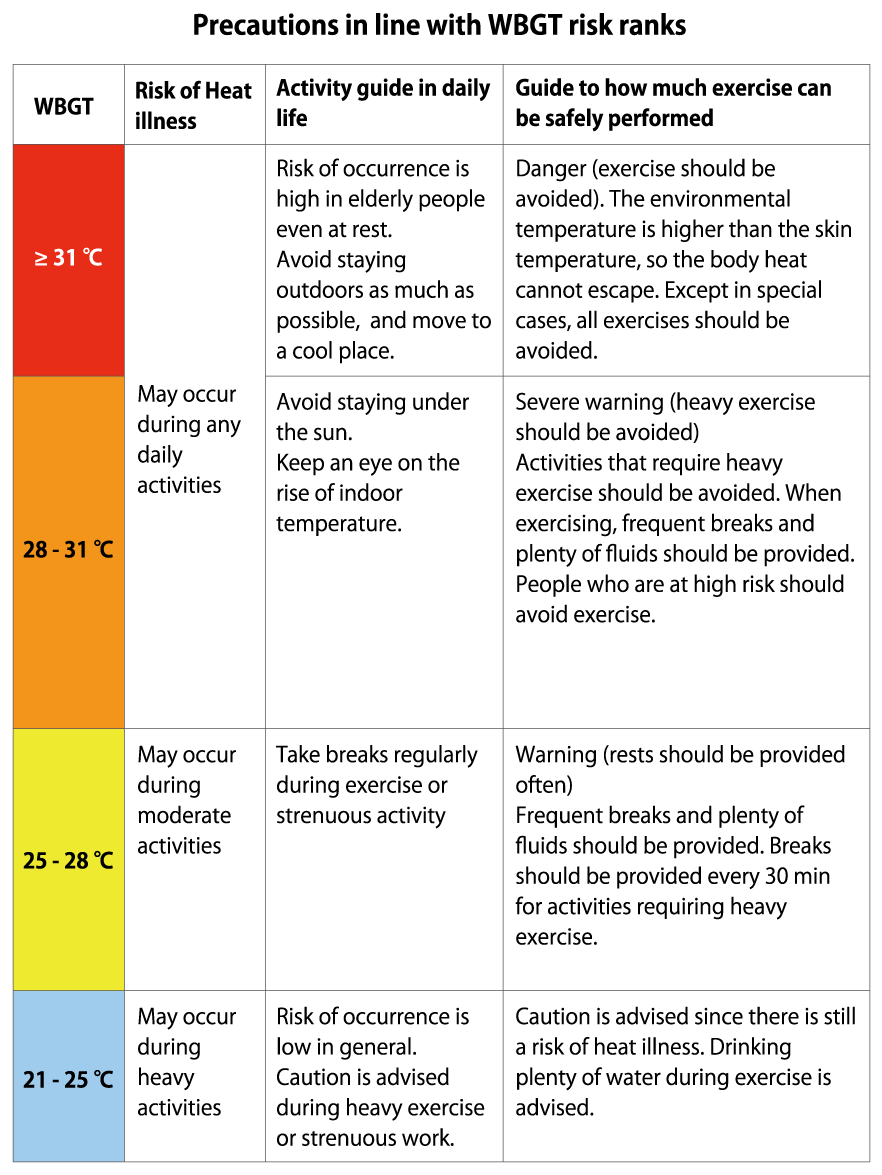July 2020
Preventing Heat Illness

The Japanese summer is characterized by not only high temperatures but also high humidity, and visitors to Japan from foreign countries can suffer in such unfamiliar conditions. When the human body cannot cope well with a hot environment, various symptoms of “heat illness” can develop. A large number of people in Japan suffer from heat illness every year, but by taking appropriate measures, such as those outlined below, heat illness can be prevented.
Heat Illness
The human body is able to maintain the core temperature within normal range by regulating heat production and diffusion. When the body temperature rises, capillaries under the skin expand to increase subcutaneous blood flow, thereby dissipating heat into the air. Sweating and the evaporation of sweat also assist the thermoregulation of the body. However, in conditions where the humidity is high, sweat is unable to evaporate, leading to heat illness. Additionally, if the increased blood flow beneath the skin significantly reduces blood flow to the brain and other vital organs, or if the sweating causes significant loss of water and salt, it may lead to heat illness. If the body is not able to regulate the rise in temperature and measures are not taken to mitigate it, heat illness will follow, symptoms of which include dizziness, light-headedness, muscle cramps, numbness in the hands and feet, headache, nausea, exhaustion, fatigue, impaired consciousness and convulsions. Therefore, individuals who feel sick in a hot environment or while exercising should suspect heat illness and take the following measures.
First-Aid Measures
If nothing is done to treat heat illness, the condition can be fatal. When symptoms of heat illness are suspected, it is necessary to quickly administer first aid. The patient should be helped to (1) take shelter in well-ventilated shade, an indoor space with an air conditioner, or some other cool environment. (2) Outer garments should be removed as well as belts and neckties loosened. If the patient is conscious, have them drink cold water or an isotonic drink. It is also effective to put a wet towel on the skin as well as a cool plastic bottle or ice on both sides of the base of the neck, under the armpits, and on the front of the base of the thighs. (3) If symptoms are severe such as impaired consciousness or an inability to drink water unassisted, the patient should immediately be taken to a medical institution by ambulance or such, and every effort should be made to cool down the patient’s body prior to arrival.
Factors that Cause Heat Illness
There are three primary factors that cause heat illness. (1) Environmental factors such as high temperature and humidity, no breeze, strong sunshine, days that suddenly become hot, and rooms with no air conditioning. (2) Physiological factors such as being elderly, an infant or obese, having a chronic disease like diabetes or a heart disease, or being dehydrated due to diarrhea or influenza. (3) Behavior-related factors such as strenuous exercise or working hard outdoors for many hours.
It is especially important to remember that about half of the people given emergency transportation for heat illness are people aged 65 or over (Fire and Disaster Management Agency statistics). Reasons for this include that elderly persons experience a decline in total body water (TBW) as well as in their ability to sense heat and feel thirst. In other words, the body's capacity to regulate heat goes down with age.
Heat Illness Countermeasures (Four Countermeasures)
Heat illness can be prevented if appropriate measures are taken. The best thing to do is “avoid heat” in the first place. To do this, (1) walk in the shade, wear light clothing, and use a parasol or hat when outside; and (2) adjust room temperature with air conditioning when indoors. It is also important to (3) rehydrate by drinking water frequently even when not thirsty—approximately 1.2 liters a day is a good guideline. It should also be noted that heat illness often happens on days when it suddenly becomes hot, particularly when the body is not accustomed to high heat. It is therefore helpful to (4) acclimatize the body to the heat by walking or doing some other form of exercise about 30 minutes a day in a slightly hot environment. Acclimatization could start around the season when it begins to get hot and might take two weeks or so to complete.
Initiatives of the Japanese Government: The Heat Stress Index (WBGT)
The Japanese government is implementing a variety of countermeasures against heat illness. One such initiative is the Ministry of the Environment of the Japanese government’s Heat Stress Index (Wet Bulb Globe Temperature: WBGT), a list of live and forecast heat intensity recorded at 840 locations across Japan which is published along with other information on the “Heat Illness Prevention Information” website (https://www.wbgt.env.go.jp/en/). WBGT is an index that shows the intensity of heat (the unit is the same as for temperature, °C) by combining figures for temperature, humidity and radiant heat, all of which have major effects on the human body. Since the index shows what measures should be taken for each stage, it is an easy reference for heat illness prevention. In particular, it is important to note that the risk of heat illness surges when the WBGT exceeds 28°C.
The heat illness prevention information website is published in English, Chinese (simplified, traditional), and Korean, and will be helpful to all foreign residents and visitors to Japan.



